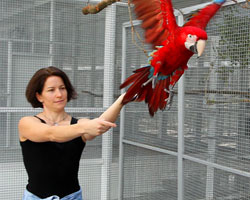The Approach
My approach to problem behavior is based in the science of applied behavior analysis. This science studies how individuals learn and is universally applicable across species. Behavior is evaluated in relation to the environment that immediately surrounds it. These environmental "brackets" are critical to understanding behavior and instrumental in developing sound behavior management plans.
My focus is on applying this science to exotic pet behavior using techniques that have been proven effective in humans as well as other animals. I use the least intrusive, most positive and humane techniques to modify behavior and improve the relationship between people and their pets. I will work with the caregiver and coach them through an evaluation process to identifying realistic approaches that can work in their unique situation. My focus is on teaching caregivers and their animals what to do in order for both to succeed. Appropriate adjustments to the environment are identified that will make the undesirable behavior less likely and desired behaviors more likely. This focus on increasing behavior leads to improved mental and physical health for the pet.
Consultations for Problem Behavior Management
Together we will:
• Clearly define the problem behavior and the environmental factors that maintain it
• Establish the final goal
• Identify needed actions
- General environmental changes
- Alternative behavior to encourage and new behavior to train
- Methods to reduce problem behavior
• Review positive reinforcement training skills
• Develop measures of success
Through this process, I hope that caregivers will gain a deeper understanding of the relationship between behavior and the environment, improve their training skills, and increase their ability to prevent or address possible behavior issues in the future.
To start the process, please fill out the Problem Behavior Consultation Initial Form.
Consultations for Training and Enrichment Techniques
Together we will:
• Define the training or enrichment goals
• Review positive reinforcement training skills
• Develop measures of success
To start the process, please fill out the Training and Enrichment Techniques Consultation Initial Form.
More information about the application of applied behavior analysis
There are many ways to answer the question, “Why does behavior happen?”, and there are many approaches scientists utilize to study behavior. Two very common approaches are the medical (or disease) model and the natural history model. The medical model postulates that problem behavior develops due to pathology (or a disease process). The natural history model postulates that problem behavior develops because it is normal for the species. The applied behavior analysis approach is different. It postulates that behavior develops because the individual animal learned to do that behavior in that setting. These models are not mutually exclusive and can (really should) be utilized together. But because the applied behavior analysis model is not well known, it is underutilized.
There are some key assumptions about behavior and its origins using applied behavior analysis that may vary significantly from how you’ve thought about behavior. Here are some highlights of using this approach.
• Behavior can not be evaluated in isolation. The environment that immediately brackets the behavior must be included in any description of the behavior. The environment immediately before the behavior “sets the stage” for the behavior (antecedent) and the environment immediately after the behavior provides feedback regarding the utility of the behavior (consequences).
• With rare exceptions, problem behavior is learned over time through inadvertent reinforcement of the behavior (though this reinforcement may be sporadic). We tend to ignore or not notice the behavior until it crosses a certain threshold, after which the behavior becomes problematic to us.
• To our animals, the behavior is functional and serves a purpose. The behavior worked for the animal in the past. The environmental consequences (i.e. the reinforcers) vary extensively for individual animals and may include getting resource such as attention or food or it may be relief from a stressful situation such as a hand going away. The reinforcement may only be offered periodically and can be difficult to identify at times.
• When working to resolve problem behaviors, use straightforward terms to describe the behavior (operationalize the behavior) and honest evaluation of the environment around the behavior. Avoid the use of labels in this type of situation. Labels (s/he’s crazy, bad, dumb, scared, smart, trying to get me, depressed, aggressive, dominant, etc.) won’t allow you to as productively problem solve.
• Acknowledge emotion, but work to move beyond it. Problem behaviors often raise a wide range of negative emotions (anger, frustration, fear, sense of failure, sadness, etc.) in us. This is natural, normal, and understandable. But getting caught up in the emotion can limit our ability to openly and honestly work toward a productive solution.
• The solution ultimately resides in teaching the animal a new behavior that is more acceptable. In addition, the environment before and after the behavior (antecedent and consequence) is often altered as well. Ultimately, we want to teach the animal an alternative behavior to get the same level of reinforcement while reducing opportunities to perform the behavior we don’t want.
• The people interacting with the animal are in the best position to identify these elements, propose workable solutions, and implement needed changes. However, outside support and coaching is extremely useful, particularly when undertaking this process for the first time.
• Because problem behavior is learned and is related to specific environmental settings and feedback, we can typically reduce the occurrence of the problem behavior to a level that is acceptable but focusing on training an alternative behavior and/or altering the environment (antecedent) to make the problem behavior less likely.


